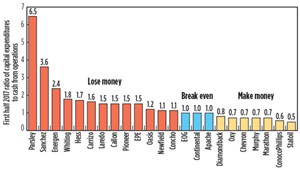What's new in exploration
Kudos to those who think the Malvinas area has potential. Same for offshore Mexico and the southeastern Mediterranean. However, a great deal of the headlines are news releases or summaries of news releases, so, of course, there is a bit of sunshine there for investors and buyers. Any decent explorationist knows all about sunshine.
Por ejemplo: Chevron acquires Anadarko—maybe. Everyone has an opinion. Chevron just told us that they might have been saving chunks from their traditional multi-billion-dollar exploration budget to buy someone else’s successful exploration. So, what’s up with Oxy then? Why we chase shale oil at a $60 break-even price remains a mystery to me, Fig. 1. I get that a great deal of geography has been tested, but I contend only minimally, especially when production decline analysis shows most conventional oil wells effectively drain less than 200 acres. End of opinion.
I like OTC. It is THE pioneer offshore group. Years ago, Houston-based SPE members invited innovative ideas from other professional organizations to show relevancy in emerging technology to offshore problems, both production and exploration. When you spend more than $100 million on a single exploration well, new, good ideas are welcome. When you are the person who recommends investing $3 billion to $5 billion to weld some floating steel together to go get that discovery online, you hope you are right. Some comfort might be found in new emerging efficiencies. Somewhere, you have to start trusting that new-to-you information. But when? Upper-level decision-makers tend to have been away from new tech for some time, and they must rely on you.
I see OTC had topics on A.I., machine learning and saving money. Is the industry ready for management to be listening to some machine programed by a 22-year-old graduate student, who knows not engineering, geology or geophysics? I ask, who is training that machine? When does the machine have enough input? How fast can the machine think? Will the human interface understand what the blinking lights mean? Will the machine apply the correct decision? Even a trained, experienced Boeing Max pilot has issues to deal with, operating a totally digital A. I. bird. Just because a machine is performing something for you, does not mean the output is desirable.
Too much information: Can information overload keep us from enjoying all that time we were going to save by adopting digital technology? Before laptops and cell phones, I used to have a job mapping groundwater in the Wyoming portion of the Black Hills. My trusty Dodge PowerWagon, a borrowed horse, a few 1:50,000 maps, green-paper print-outs, and George Custer’s 1870s journal was all I needed. My boss in Cheyenne kept calling me to return to his office; I did not, until he sent a junior to collect me. Why? To program and run the office’s new computer, barely a calculator today. Worse. Some guy (Gates) in Seattle invented DOS. My time has been captured ever since by all sorts of devices that allow anyone in the world to find me with what they want. A.I. cannot rescue us from this elemental condition. I miss that horse.
Tech-driven information still has issues: Rock physicists still try to decipher—that is investigate—depth issues that control seismic images and those pesky synthetic seismograms created from sonic logs that never seem to quite fit the seismic data scales of the volume in view. Why? Interpreters often forget that every millisecond of two-way time that they view has a density and velocity component. In most situations, velocity and density increase with depth. Every 1.0-ms time window is “physically thicker” than its preceding window. Images on workstations are cool, but they often are viewed as mono-dimensional. AAPG Memoir 26,P. Vail, taught us that seismic reflectors follow depositional surfaces, not time surfaces.
All computer-driven seismic synthetics start as zero offset, zero phase assumptions. We compare them to summed traces of all offsets, all amplitude effects, even if created miles away from zero. The relationship of wave shape to wave size to rock reality is never one to one. Interpreters have lived with this issue since the first synthetic. At Conoco, we actually processed offset traces to mirror the zero phase, near trace. Once AVO was officially born, we gleefully ran with offset gathers as a new DHI tool that worked at least some of the time, when above geopressure. We made graphs of I to IV to explain types of gas-charged GOM sands. However, everyone tractored timing offsets to comply with zero offset, P wave assumptions. Phase of offset traces on our pre-stack data were relevant, only if there was a change from zero to –180 or an apparent “swelling” of amplitudes. No one, then, cared that if a P wave is converted to S wave, it should be slower and out of x,y,z position, relative to non-converted waves. We care now. WO

- Digital transformation/Late-life optimization: Harnessing data-driven strategies for late-life optimization (March 2024)
- The reserves replacement dilemma: Can intelligent digital technologies fill the supply gap? (March 2024)
- Digital tool kit enhances real-time decision-making to improve drilling efficiency and performance (February 2024)
- Digital transformation: Digital twins help to make the invisible, visible in Indonesia’s energy industry (January 2024)
- Digital transformation: A breakthrough year for digitalization in the offshore sector (January 2024)
- Quantum computing and subsurface prediction (January 2024)



